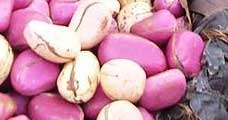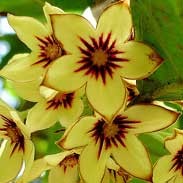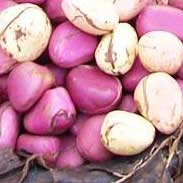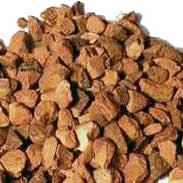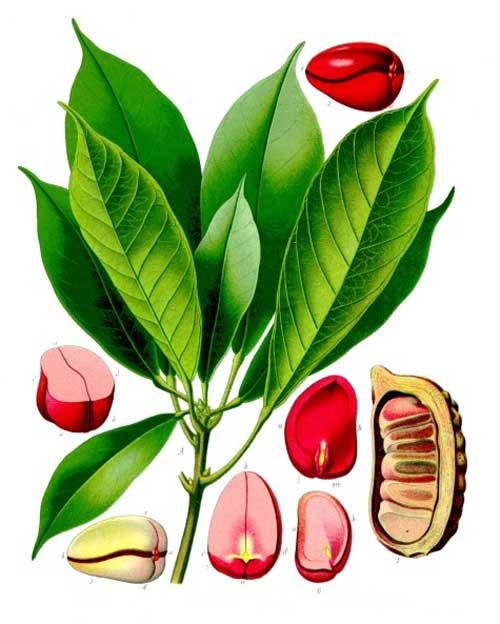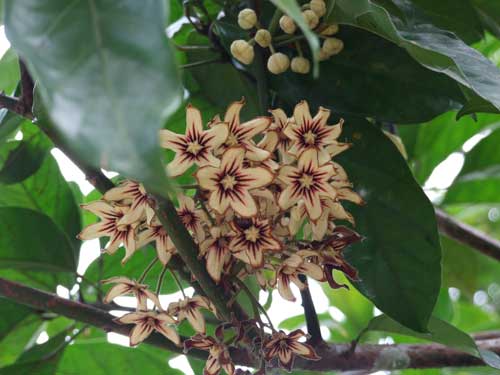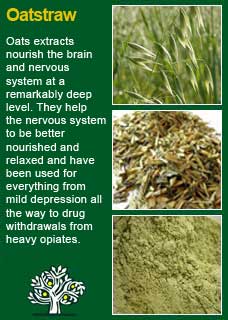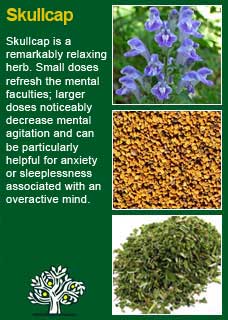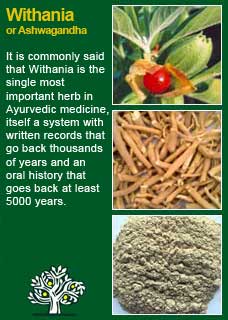
|
|
||||
| Our Pages ABOUT CONSTITUTIONAL MEDICINE
|
Kola nut (equally as often called Cola nuts) come from a large, evergreen tree that can grow to over 20 meters tall. The Kola tree is native to Western Africa and grows widely in the low-lying evergreen forests of Africa to this day. The nuts are a dark reddish brown, about 2-3 cms across and have a slightly bitter and astringent taste.
In the late 1800s a chemist called John Pemberton combined extracts from Kola nut, Coca leaves and mixed them with sugar, flavourings and carbonated water and made the first batch of ‘Coca-Cola’... and so what eventually became a global industry was born! In West Africa there are deep connections to Kola for everything from chewing them as an everyday pastime right through to their being potently religious symbols. In terms of medicinal action, Kola nut is especially regarded in this part of the world as being effective for restoring vitality and relieving hunger pangs. Kola nuts have high amounts of the stimulating alkaloids caffeine and theobromine. Are they more stimulating to the central nervous system than their much more popular cousin the coffee bean? Probably yes, Kola nuts certainly contain a significantly higher percentage of the active stimulant ingredients compared to coffee. In Western herbal medicine Kola nuts have had a strong traditional use for strengthening a weakened heart muscle and for depression, nervous debility and for exhaustion where some degree of stimulation is acceptable. Kola nut has also been historically used to treat diarrhoea and bowel looseness where this is associated with nervous system exhaustion. Kola has been classed as a bronchodilator (it opens up the airways) and so has also been used to assist in the treatment of asthma and whooping cough. F Ellingwood writes 'the natives of the western portion of tropical Africa use the seeds of Kola most extensively to overcome fatigue, to support the strength on long marches, and to overcome depression of spirits and melancholy. It is most highly esteemed and is in as common use as tea, coffee and cocoa in civilized countries. The agent sustains physical strength to a remarkable degree. It is a tonic to the heart, increasing the strength of its impulse; it regulates the pulse, increases arterial tension, induces diuresis, but retards tissue metabolism. It is a stomachic tonic, inducing a normal appetite and good digestion. It restores normal action in debilitated conditions of the intestinal tract. It is used in neurasthenia, characterized by great mental despondency, foreboding, brooding of a quiet or silent character. It is especially indicated if the heart is feeble and irregular in its action, with general muscular feebleness. It is an excellent restorative after prostrating fevers and protracted exhausting disease. It is of specific value in melancholia. In weak and enfeebled conditions of the heart muscle, with valvular weakness, dyspnea (laboured breathing) & irregular action, it is of benefit, the influence being quickly exhibited on the pulse, and an improved sense of well-being experienced. It is advised in chronic diarrheas, with great lack of tone. It has been used in sea sickness, one ship surgeon claiming that he had used it on many voyages, and had found it to relieve even the most susceptible, in many cases. The agent is without doubt a valuable one in its field' H Felter writes 'the physiological action of Kola closely duplicates that of caffeine and the caffeine-bearing drugs. It is, therefore, a remedy for muscular and nervous depression due to cerebral and spinal anemia. It is useful in hysteria, mental gloom, neurasthenia, and the diarrhea of debility. It may be used in acute alcoholism, but is of no value in chronic inebriation, and it sustains one attempting to break away from the tobacco-habit. It relieves nervous irritability of the stomach, often checking the nausea of pregnancy and the vomiting of seasickness. Its action in chronic diarrhea must be due to its power over irritation, as there is not sufficient tannin in the drug to cause much astringency. Like caffeine King's Dispensatory writes 'the action of kola has been compared to that of coffee and cocoa, but it differs even from these, and from that of the two principles—caffeine and theobromine—contained in it. Upon the stomach it appears to exert a tonic influence, improving digestion. It increases the functions of the cerebro-spinal system and sympathetic system. This is the effect of small and medium doses, rendering one capable of severe mental exertion, overcoming mental depression, and the tendency to somnolency (excess sleepiness) Large doses produce overstimulation, and thus tend to destroy the usefulness of the drug when given in proper doses. Physical strength is augmented and sustained by kola, its action upon the muscular system, increasing contractility, being pronounced. Kola is undoubtedly of value in certain conditions, hinging chiefly on nervous depression. The guiding symptoms, after protracted illness, are mental depression, tendency to faintness, marked nervous irritability, poor appetite and digestion, and great muscular debility' The British Herbal Pharmacopoeia (BHP) describes Kola nut's actions as stimulant to higher centers of the central nervous system, thymoleptic, antidepressive, diuretic, cardioactive, antidiarrhoeal and says it is indicated for depressive states, melancholia, atony, exhaustion, dysentery, atonic diarrhoea, anorexia, migraine and specifically indicated for depressive states associated with general muscular weakness. The BHP suggests a dose of 1-3 gms or by decoction and recommends a tincture in the ratio of 1:5 in 60% ethanol with a dose of 1-4mls. ~ There are over 150 published studies and articles on Kola nut; a PDF showing their titles, authors and when and where they were published can be found here
For some years now, against this proven and safe way of herbalism, there has been a rising tide of excessive caution and scare-mongering in many parts of the world. The same authorities that, not so long ago, decried herbal medicines as ineffectual, have now taken up a different adversarial position; that they are dangerous substances that should only be prescribed by Doctors, who of course have zero training in them. Unfortunately, the same unnecessary fear and worry has crept into many natural health websites and popular publications on herbs. Herbs that we have safely used for thousands of years, that have no reports of adverse reactions in the medical literature despite widespread use by millions of people, are suddenly described as contraindicated because of something that should have been seen as completely unimportant, or at the utmost a merely theoretical concern, such as a laboratory study on one of the herb's constituents to use an all too common example. I wonder sometimes if the writers of such articles feel that the herb will be more deserving of respect if it is thought to be a little bit dangerous, in other words more like a drug than something that has simply come out of the earth and been used by ordinary people for generations beyond count. There is just so much misinformation about herbal medicine on the internet now. Ludicrous claims and cautions abound in equal measure; it seems like one group are trying to make money out of the public whilst the other are busily trying to scare them off. I have to believe that the kind of reader who takes the time to read pages on herbs that are as extensive as this one is much less likely to be swayed by marketers or misinformers. I hope that you will keep your wits about you if you get conflicting opinions from people who have never really got to know these herbs, who have never worked with them, or learned how to use them safely and effectively. I want to remind you that the reason that herbs can never be patented and owned by any individual or corporation is because they are, and always will be, the People's medicine. They belong to all of us and it is my great hope in sharing this work that you will learn how to use them wisely for yourself, and the people you care for. Be safe, but do not be afraid.
When you latch on to one ingredient of a herb you tend to start thinking in an equally one-dimensional manner about what it does. Kola nut does have plenty of caffeine and another well-known stimulant, theobromine in it, and it clearly is a herb that stimulates the central nervous system but these are only two of hundreds of ingredients that are contained within the extract, of the Kola nut. and to stop there is to miss much of what this plant medicine can do., I use Kola nut for people who need some help getting into the 'activation' phase of their cycle of healing, a subject that is introduced further in the section below on constitutional medicine, and there is a delicate art of knowing both when to safely use it as well as then how much to give. The person who is too tired but who is also too tense is probably unlikely to benefit from Kola. Such people often use too much stimulants anyway and adding another will do nothing good in the long term. However, for the person who is exhausted, who simply feels weak and without strength, who cannot find the impetus to push themselves forwards into a healthier lifestyle, there might be no other herb that could help them as much as Kola, at least in the beginning. I always say to let Nature take the first step in the healing journey. To let Nature give a person enough support that they can take the next step themselves. For some person who become chronically low in mood and energy, the number one thing they can do to help themselves is to get 'activated' again. For example, to start mentally and/or physically exercising. Movement will get them out of the rut they have become stuck in. Such a person often knows full well themselves already that this is exactly what they need to do, but without support it never gets past wishful thinking; nothing actually happens. For some such people, Kola nut has sometimes clearly been of great value. It lifts the spirits, gives energy, helps them to get started, to get momentum, and then they can keep themselves going without it. However, I am keenly aware of the danger of giving a stimulant to a person who is in a state of exhaustion. There is a very real risk that, even if it works and they get some energy to get active, that we can end up robbing Peter to pay Paul, and they may eventually fall back to a lower level of health then they were before taking the stimulant. Great care is needed to follow the first rule of 'do no harm' so, in my own practice with Kola nut, this is a herb that I am particularly likely to want to use the ancient method of pulse testing to feel if this is a substance that the intelligence of the body knows will be good for it to take for a while. I do this in a way that I have no knowledge of whether it the Kola or some other herb that is being tested, and neither does the patient, so it is a 'double-blind' test. This interesting subject is described in further practical depth here Another reason I have occasionally found Kola nut to be the 'right herb' is for the person who really needs to lift their level of performance for a short period of time, for example students needing to cram for exams, or athletes who are coming into a major event, or people who are travelling and need to get into action soon after their arrival and not be suffering unduly from jet-lag. In such instances, and indeed in using Kola nut is most cases, I will give it as a formula to take on the early part of the day and then given another combination of herbs, perhaps based on Valerian, Hops, Skullcap or Passionflower, to take at the end of the day to help ensure a deep, restful sleep to further balance the effect of giving a stimulant in the morning. Dosage is always critical to get right in herbal medicine. Too much Kola will be over-stimulating, too little won’t work. To make things more complicated still, what is too high for one person is too low for another and vice versa. I think that around 3 or 4 mls is about average for what will give a sure effect, but I would use half or even less than that for a more sensitive person, or for someone for whom I only wanted the action to come in at a subtle level. For example, just 1 ml in a formula can give a considerable degree of stimulation without there needing to be too much worry about overdoing it. Bear in mind that this is with Kola nut extract that we make ourselves. and that different preparations will have varying strengths, especially according to the potency of the starting material and the method of extraction. For anyone who didn't know how strong their preparation was, I would suggest starting with a little, just half a ml or about 10 drops, and then gradually build up from there. A little Kola nut can go a long way and too much Kola nut is not nice. Kola nut combines very well with other such tonic herbs as Skullcap, Oatstraw and Withania and I am sure that using such gentle and nourishing tonics along with the Kola nut also does much to offset the danger of overstimulation or dependency.
Much of the information here about the traditional uses of Kola nut is consistent with the model of thinking whereby one may treat problem A with plant B. There is value in this approach, especially in how it helps us pass on useful knowledge to one another, but it falls short in one vital area; and that is that people are not all cut from the same cloth! Something that works brilliantly for one person may do less for another -- why is this? Part of the reason is that people vary in their constitutions as to whether they are either hotter or cooler and, at the same time, either dryer or damper. This useful and rather fascinating subject is introduced further here Another big part of using the right herb when it is most needed comes from understanding the need to treat what is going wrong for the person that had led up to their getting a health condition. In this light, Kola nut can particularly offer its benefits when an activation is needed in the 'cycle of healing', more about this here
Please understand that I cannot advise you, including on products or dosage, without seeing you in person in my clinic but for ideas
on how you might find a good herbalist in your area read here |
|
|
|
© 2011 R.J.Whelan Ltd
